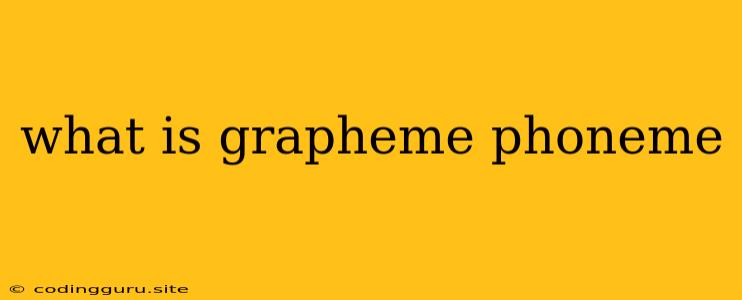What are Graphemes and Phonemes?
Have you ever wondered how we translate the written word into the spoken word? It's a process that seems effortless, but it involves a complex interplay between graphemes and phonemes. This article will explore the fundamental differences between these two concepts and how they work together to form the basis of our language.
Graphemes are the written representations of sounds. They are essentially the letters, or combinations of letters, that we use to write words. Phonemes, on the other hand, are the smallest units of sound in a language. They are the distinct sounds that we use to create words when we speak.
Here's a simple analogy: Imagine a building block. The building block itself is like a grapheme, a single unit that can be combined with other units to create something bigger. The sound that the building block makes when you drop it is like a phoneme, the basic unit of sound.
The Connection Between Graphemes and Phonemes
While graphemes and phonemes are distinct concepts, they are inextricably linked. The written language we use is designed to represent the sounds of our spoken language. This means that each grapheme, or letter, usually corresponds to a specific phoneme, or sound.
For example, the grapheme "c" in the word "cat" represents the phoneme /k/. Similarly, the grapheme "a" represents the phoneme /æ/, and the grapheme "t" represents the phoneme /t/.
The Challenges of Graphemes and Phonemes
However, the relationship between graphemes and phonemes is not always straightforward. There are some challenges to consider:
-
Multiple Pronunciations: Some graphemes can represent multiple phonemes. Take the grapheme "g," for example. It can represent the phoneme /g/ in "gate" or the phoneme /dʒ/ in "gem."
-
Silent Letters: Some graphemes are present in a word but do not represent a phoneme. For instance, the "e" at the end of the word "make" is silent.
-
Digraphs: Sometimes, two graphemes are combined to represent a single phoneme. For example, the digraph "sh" represents the phoneme /ʃ/ in "ship."
-
Multiple Graphemes for One Phoneme: Conversely, a single phoneme can be represented by multiple graphemes. The phoneme /k/ can be represented by the graphemes "c" in "cat," "k" in "kite," and "ck" in "pack."
The Importance of Understanding Graphemes and Phonemes
Understanding the relationship between graphemes and phonemes is essential for:
-
Reading: By understanding the relationship between letters and sounds, we can decode words and pronounce them correctly.
-
Spelling: Being aware of the different ways that phonemes can be represented in writing helps us spell words accurately.
-
Language Learning: Learning a new language often involves mastering the correspondence between graphemes and phonemes in that language.
Conclusion
Graphemes and phonemes are fundamental building blocks of language. While they are distinct concepts, their relationship is crucial for our ability to read, write, and communicate effectively. By understanding the complexities of this relationship, we can gain a deeper appreciation for the intricate structure of language.
